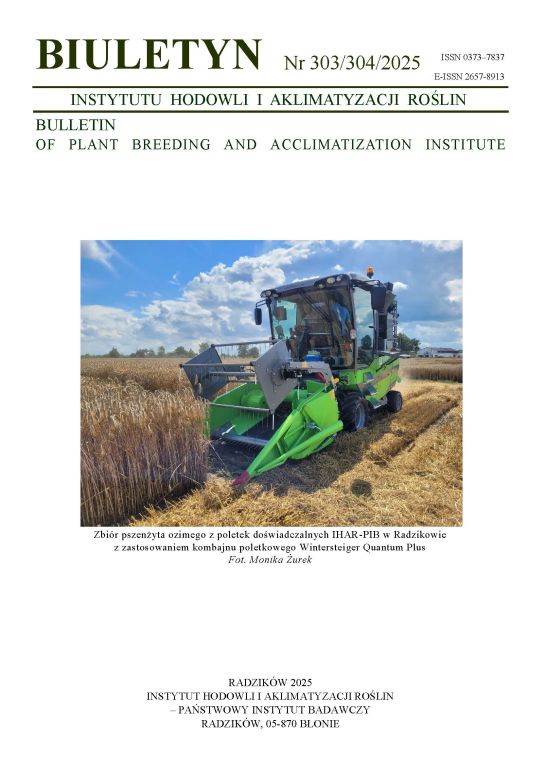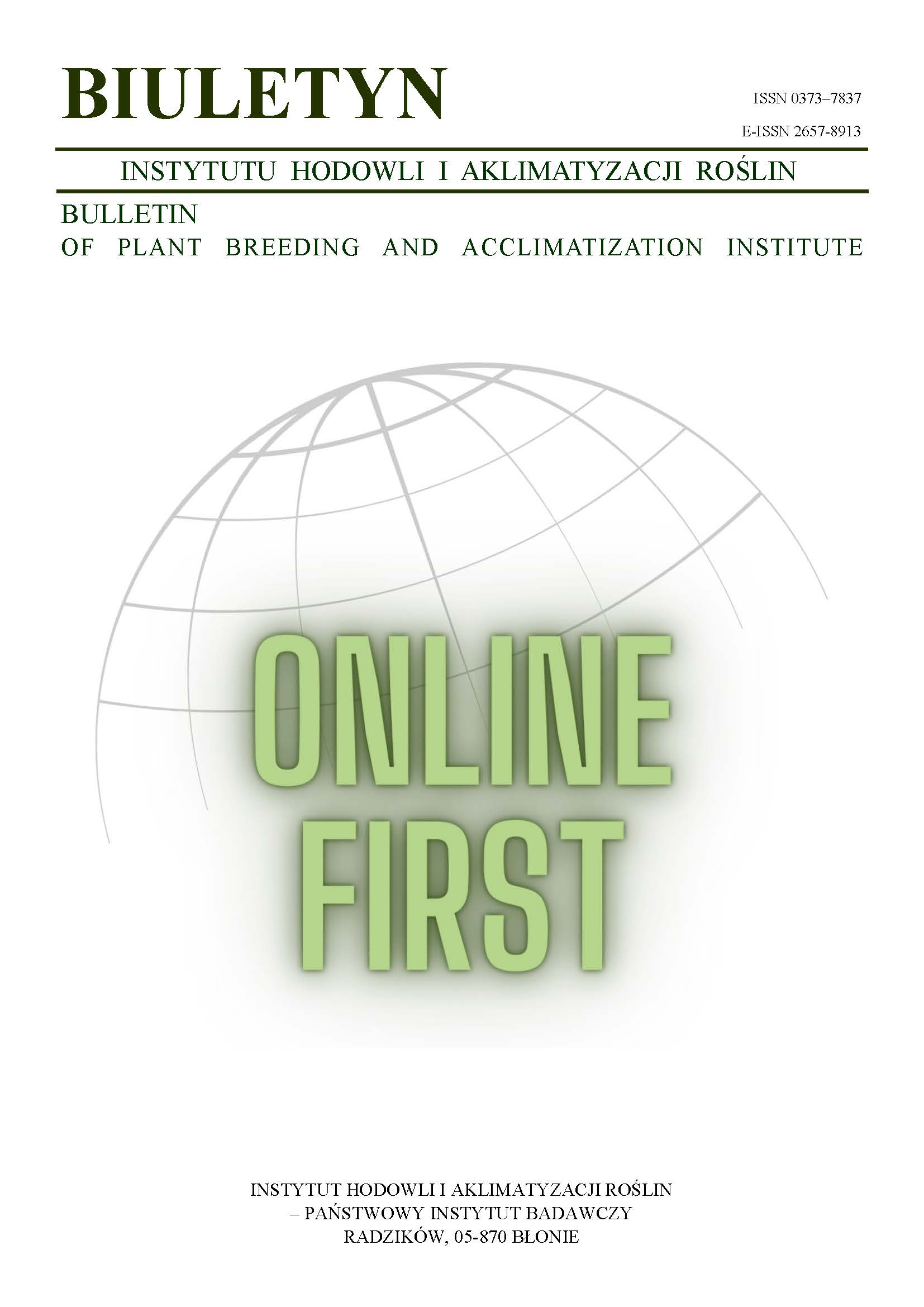Wrażliwość odmian ziemniaka na metrybuzynę
Tadeusz Gruczek
t.gruczek@ihar.edu.plZakład Agronomii Ziemniaka, Instytut Hodowli i Aklimatyzacji Roślin, Oddział Jadwisin (Poland)
Abstrakt
Celem badań było określenie wrażliwości odmian zarejestrowanych w latach 1995–2002 na metrybuzynę, stosowaną po wschodach ziemniaka w dawce 350 gram substancji biologicznie czynnej (0,5 kg na 1 ha preparatu Sencor 70WG). Odmiany badano w cyklu 2–3 letnim. Wrażliwość odmian określano za pomocą 9° skali EWRC (European Weed Research Council). Na podstawie reakcji odmian, wyrażonej skalą porażenia, zakwalifikowano odmiany do 4 grup. Określono wpływ warunków pogody na wrażliwość odmian i spadek plonu powodowany uszkodzeniami roślin ziemniaka.
Słowa kluczowe:
metrybuzyna, odmiany, opady, plon, temperaturaBibliografia
Canshow W. S., Thoronton M. K. 1988. Effects of systemic insecticides on potato growth and their interaction with metribuzin. Am. Potato J., vol. 65: 535 — 541.
DOI: https://doi.org/10.1007/BF02908333
Google Scholar
Gójski B. 1987. Reakcja 40 odmian ziemniaka na herbicyd Sencor w 1986 r. Mat. Konf. “Agrotechnika ziemniaka i wybrane zagadnienia z przechowalnictwa”. Bonin 4–5 marca: 167 — 168.
Google Scholar
Gójski B. 1996. Szacunek strat plonu ziemniaka w skali kraju z powodu zachwaszczenia plantacji. Mat. Konf. “Makroproblemy produkcji ziemniaka w Polsce w okresie przemian organizacyjno-ekonomicznych”. IHAR Jadwisin 6–7 lipca: 32 — 35.
Google Scholar
Gruczek T. 2001. System pielęgnowania a jakość plonu. Frag. Agron. 4: 37 — 50.
Google Scholar
Kolbe W., Zimmer K. 1972. Sencor a herbicide of the triazinone group. Pflanzenschutz — Nachr. Bayer 25 nr 2: 175 — 185.
Google Scholar
Kolbe W., Zimmer K. 1972. Studies on chemical control of weeds with the soil — applied and foliar — acting herbicide Sencor in potatoes and vegetables, with consideration to varietals tolerance. Pflanzenschutz — Nachr. Bayer 25 nr 2: 210 — 217.
Google Scholar
Pawińska M., Urbanowicz J., Gawińska-Urbanowicz H. 2001. Występowanie i zakres zwalczania głównych agrofagów ziemniaka w sezonie wegetacyjnym 2000 na tle lat poprzednich. Mat. Konf. „Ochrona ziemniaka”. Kołobrzeg 19–20 kwietnia. Bonin: 29 — 36.
Google Scholar
Pawińska M., Urbanowicz J., Osowski J. 2002. Występowanie, szkodliwość i zwalczanie niektórych agrofagów ziemniaka w 2001 roku w porównaniu z latami ubiegłymi. Mat. Konf. „Ochrona ziemniaka”. Kołobrzeg 11–12 kwietnia, IHAR Bonin: 7 — 11.
Google Scholar
Pawińska M., Urbanowicz J. 2003. Występowanie i zwalczanie chwastów oraz stonki ziemniaczanej w sezonie wegetacyjnym 2002. Mat. Konf. „Nasiennictwo i ochrona ziemniaka”. Kołobrzeg 24–25 kwietnia, IHAR Bonin: 29 — 31.
Google Scholar
Praczyk T. 2002. Diagnostyka uszkodzeń herbicydowych roślin rolniczych. PWRiL, Poznań: 52 — 64.
Google Scholar
Roztropowicz S. 1999. Metodyka obserwacji, pomiarów i pobierania prób w agrotechnicznych doświadczeniach polowych. IHAR Jadwisin: 16 — 17.
Google Scholar
Sawicka B. 1993. Wpływ terminów stosowania herbicydu Sencor 70WP na plon ogólny i handlowy 44 odmian ziemniaka. Fragm. Agron. 3: 49 — 58.
Google Scholar
Sawicka B. 1994. The response of 44 varieties of potato to metribuzine. Rocz. Nauk Rol. ser. E t. 23 z. 1/2: 103 — 123.
Google Scholar
Sawicka B. 1997. Zachwaszczenie ziemniaka w warunkach stosowania herbicydu Sencor 70WP. Cz. II. Rocz. Nauk Roln. ser. A. t. 112, z. 1–2: 183 — 191.
Google Scholar
Schmidt R. R. 1974. Sencor in der Biosphere. Nachrssl. Dt. Pflanzenschutzdienst. Stuttgard., vol. 26, 5: 69 — 71.
DOI: https://doi.org/10.1007/978-3-642-96230-1_3
Google Scholar
Urbanowicz J., Erlichowski T. 1999. Zastosowanie herbicydu Sencor 70WG w różnych dawkach i terminach aplikacji do odchwaszczania plantacji ziemniaka. Mat. Konf. “Ochrona ziemniaka”. Kołobrzeg 23–24 marca, IHAR Bonin: 131 — 135.
Google Scholar
Urbanowicz J. 2002. Wrażliwość odmian ziemniaka na metrybuzynę w świetle dotychczasowych badań. Mat. Konf. “Ochrona ziemniaka”, Kołobrzeg 11–12 kwietnia, IHAR Bonin: 21 — 22.
Google Scholar
Zarzecka K. 1997. Wpływ pielęgnacji na zachwaszczenie, wysokość i jakość plonu bulw ziemniaka. Rozpr. Nauk. WSR-P Siedlce: 82 s.
Google Scholar
Zarzecka K. 2000. Zależność plonowania ziemniaka od zachwaszczenia. Fragm. Agron. 2: 120 — 134.
Google Scholar
Autorzy
Tadeusz Gruczekt.gruczek@ihar.edu.pl
Zakład Agronomii Ziemniaka, Instytut Hodowli i Aklimatyzacji Roślin, Oddział Jadwisin Poland
Statystyki
Abstract views: 144PDF downloads: 43
Licencja
Prawa autorskie (c) 2004 Tadeusz Gruczek

Utwór dostępny jest na licencji Creative Commons Uznanie autorstwa – Na tych samych warunkach 4.0 Miedzynarodowe.
Z chwilą przekazania artykułu, Autorzy udzielają Wydawcy niewyłącznej i nieodpłatnej licencji na korzystanie z artykułu przez czas nieokreślony na terytorium całego świata na następujących polach eksploatacji:
- Wytwarzanie i zwielokrotnianie określoną techniką egzemplarzy artykułu, w tym techniką drukarską oraz techniką cyfrową.
- Wprowadzanie do obrotu, użyczenie lub najem oryginału albo egzemplarzy artykułu.
- Publiczne wykonanie, wystawienie, wyświetlenie, odtworzenie oraz nadawanie i reemitowanie, a także publiczne udostępnianie artykułu w taki sposób, aby każdy mógł mieć do niego dostęp w miejscu i w czasie przez siebie wybranym.
- Włączenie artykułu w skład utworu zbiorowego.
- Wprowadzanie artykułu w postaci elektronicznej na platformy elektroniczne lub inne wprowadzanie artykułu w postaci elektronicznej do Internetu, lub innej sieci.
- Rozpowszechnianie artykułu w postaci elektronicznej w internecie lub innej sieci, w pracy zbiorowej jak również samodzielnie.
- Udostępnianie artykułu w wersji elektronicznej w taki sposób, by każdy mógł mieć do niego dostęp w miejscu i czasie przez siebie wybranym, w szczególności za pośrednictwem Internetu.
Autorzy poprzez przesłanie wniosku o publikację:
- Wyrażają zgodę na publikację artykułu w czasopiśmie,
- Wyrażają zgodę na nadanie publikacji DOI (Digital Object Identifier),
- Zobowiązują się do przestrzegania kodeksu etycznego wydawnictwa zgodnego z wytycznymi Komitetu do spraw Etyki Publikacyjnej COPE (ang. Committee on Publication Ethics), (http://ihar.edu.pl/biblioteka_i_wydawnictwa.php),
- Wyrażają zgodę na udostępniane artykułu w formie elektronicznej na mocy licencji CC BY-SA 4.0, w otwartym dostępie (open access),
- Wyrażają zgodę na wysyłanie metadanych artykułu do komercyjnych i niekomercyjnych baz danych indeksujących czasopisma.
Inne teksty tego samego autora
- Tadeusz Gruczek, Barbara Lutomirska, Genowefa Sowa-Niedziałkowska, Podatność odmian ziemniaka na uszkodzenia mechaniczne bulw i straty przechowalnicze , Biuletyn Instytutu Hodowli i Aklimatyzacji Roślin: Nr 232 (2004): Wydanie regularne














